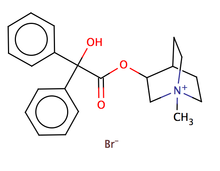- Clidinium bromide
-
Clidinium bromide 
Systematic (IUPAC) name 3-[(2-hydroxy-2,2-diphenylacetyl)oxy]-1-methyl-1-azabicyclo[2.2.2]octan-1-ium bromide Clinical data AHFS/Drugs.com monograph MedlinePlus a601036 Pregnancy cat. ? Legal status ℞-only (US) Routes Oral Pharmacokinetic data Bioavailability Low Excretion Renal and biliary Identifiers CAS number 7020-55-5  3485-62-9
3485-62-9ATC code A03CA02 (combination with psycholeptics) PubChem CID 2784 IUPHAR ligand 351 DrugBank APRD00737 ChemSpider 2682 
UNII BO76JF850N 
ChEMBL CHEMBL1200950 
Chemical data Formula C22H26NO3+ Mol. mass 352.447 g/mol SMILES eMolecules & PubChem  (what is this?) (verify)
(what is this?) (verify)Clidinium bromide (INN) is an anticholinergic drug. It may help symptoms of cramping and abdominal/stomach pain by decreasing stomach acid, and slowing the intestines. It is commonly prescribed in combination with chlordiazepoxide (a benzodiazepine derivative) using the brand name Librax.
Contents
Uses
Peptic ulcer disease
Used in fixed combination with chlordiazepoxide as adjunctive therapy in the treatment of peptic ulcer disease; however, no conclusive data that antimuscarinics aid in the healing, decrease the rate of recurrence, or prevent complications of peptic ulcers.
With the advent of more effective therapies for the treatment of peptic ulcer disease, antimuscarinics have only limited usefulness in this condition.
GI motility disturbances
Used in fixed combination with chlordiazepoxide in the treatment of functional GI motility disturbances (e.g., irritable bowel syndrome).
Has limited efficacy in treatment of GI motility disturbance and should only be used if other measures (e.g., diet, sedation, counseling, amelioration of environmental factors) have been of little or no benefit.
Acute enterocolitis
Used in fixed combination with chlordiazepoxide in the treatment of acute enterocolitis. However, antimuscarinics should be used with extreme caution in patients with diarrhea or ulcerative colitis.
Preclinical studies
Clidinium is an effective anticholinergic agent with activity approximating that of atropine sulfate against spasms induced by acetylcholine in isolated intestinal strips. On oral administration in mice it proved an effective antisialagogue in preventing salivation induced by pilocarpine. Spontaneous intestinal motility in both rats and dogs is reduced following oral dosing with 0.1 to 0.25 mg/kg. Potent cholinergic ganglionic blocking effects (vagal) are produced with intravenous usage in anesthetized dogs.
Oral doses of 23 mg/kg administered to dogs produced nasal dryness and slight pupillary dilation. In two other species, monkeys and rabbits, doses of 5 mg/kg by mouth, three times a day, for 5 days produced no apparent changes.
External links

This drug article relating to the gastrointestinal system is a stub. You can help Wikipedia by expanding it.
